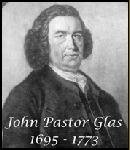Old
Scots Independents John Smith, Newburn and Robert Ferrier, Largo
having read the papers of Sandeman meet at Balchristie mid point to
their parishes to discuss the content. “Like the Secession and
Relief Churches this denomination had its origin in Fife. The
founders James Smith of Newburn and Robert Ferrier of Largo, were
neighbouring ministers of the Church of Scotland, who, on adopting
views very similar to those of Glas, resigned from their membership
of the National Church in 1768. They organised a congregation at
Balchristie, in Newburn Parish, on Independent lines, they themselves
being appointed the joint pastors, and deacons being appointed for
the administrative work.
Laurie
says:- "It has been often remarked, that Newburn,
for many years past, has been a nursery of Seceders;
and remarked with surprise, that a small arm of the sea should be the
boundary between moderation and fanaticism. Cameronians,
Independents, persons belonging to the Burgher
Congregation, and also to what is called the Relief Congregation, are
to be found here. The number of Independents is about 20. They are
the only sect who have a place of meeting for public worship in the
parish." In spite of their dissenting propensities the
parishioners were sober, regular, industrious, and humane, and their
diversity of sentiments did not prevent social intercourse nor mutual
good offices. The Seceders
had not increased of late, and one of the Relief elders had returned
to the Established Church;
and so, to Mr Laurie, "rational religion" seemed to be
gaining ground, and he fondly hoped that "the small remainder of
enthusiasm" would most probably die with those who cherished it.
His hopes were so far realised, in 1836, that the Independent
Congregation had removed their place of meeting to Earlsferry,
their Church
at Balchristie
being turned into a granary, and there were only three. dissenting
families in the whole parish.
In
1768 at about the same time a small group in Glasgow
withdrew from the Church of Scotland because of interference by the
magistrates and town council in the Congregational choice of a
minister, and built for themselves a chapel, long known as "the
Candle Kirk." Mr. Ferrier came to Glasgow to be joint pastor
with the celebrated Robert Dale, a Glasgow merchant; while a Largo
weaver became a colleague at Balchristie of Mr. Smith. Dale was the
first layman to officiate as a minister in Glasgow, and some
indignation was stirred up in the city against him and their cause.
But both survived, and new societies were formed in Montrose,
Marykirk, Perth, Methven, Kirkaldy, Hamilton, Paisley, Dundee,
Newburgh, Sauchieburn, Edinburgh, Galashields, Airdrie and
Earlsferry.” They never became a large body. There was the same
divisive tendency as amongst the Glasites. Moreover two other bodies
were growing up side by side with them, which drew away many of their
members, namely, the Scotch Baptists and the New Independents or
Haldaneites. David Dale and set up a Chapel of easewhich in 1769 became an independent Church with Dale as one of the
elders. Both Dale and the Balchristies historically known as Old
Scots Independents- small, and sharing Glasite ideas of Church life
and practice.


